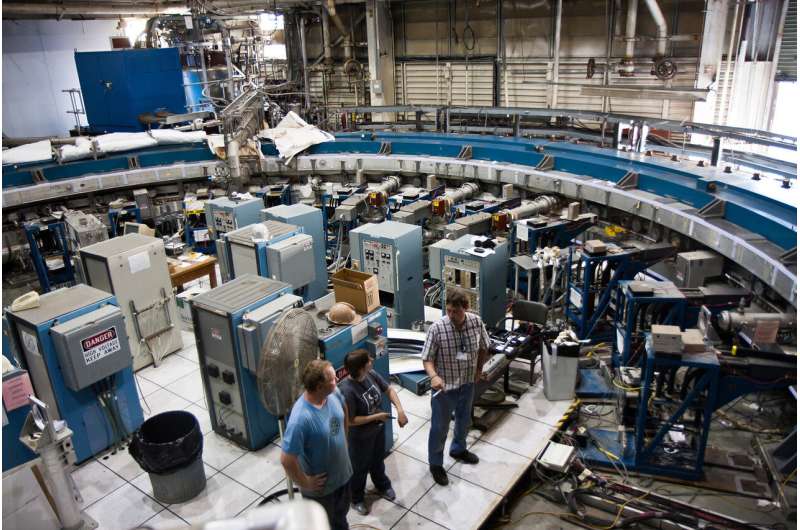
September 13, 2024 by David Appell , Phys.org
Collected at: https://phys.org/news/2024-09-fundamental-magnetic-property-muon-unprecedented.html
Scientists have measured the magnetic moment of the muon to unprecedented precision, more than doubling the previous record.
Physicists from the Muon g-2 Collaboration cycled muons, known as “heavy electrons,” in a particle storage ring at Fermilab in the United States to nearly the speed of light. Applying a magnetic field about 30,000 times stronger than Earth’s, the muons precessed like tops around their spin axis due to their own magnetic moment.
As they circled a 7.1-meter diameter storage ring, the muon‘s magnetic moment, influenced by virtual particles in the vacuum, interacted with the external magnetic field. By comparing this precession frequency with the cycling frequency around the ring, the collaboration was able to determine the muon’s “anomalous magnetic moment” to a precision of 0.2 parts per million.
This muon magnetic moment measurement is the latest in a string going back to 2006, with the original performed at Brookhaven National Laboratory on Long Island, New York. Each subsequent experiment has improved the precision of the measurement. The precision of the latest measurement is 2.2 times better than the same group’s previous determination based on earlier data. The Muon g-2 Collaboration consists of 181 scientists from seven countries and 33 institutions; their latest work was published in Physical Review D.
Muons are 207 times more massive than an electron, but otherwise identical, with the same electric charge and spin. (“Who ordered that?” exclaimed physicist and eventual Nobel Laureate Isidor Isaac Rabi when the muon was discovered in 1936. An even more massive cousin in this lepton family was discovered in 1975, called the tau, with a mass 3,477 times that of the electron.)
Determining lepton magnetic moments, both theoretically and experimentally, represents a pinnacle of scientific achievement. The electron’s magnetic moment is now known to 11 significant digits with a relative accuracy of one part in 10 trillion. Amazingly, the theoretical prediction calculated via Feynman diagrams of quantum electrodynamics (QED) agrees with the measured value to 10 significant figures.
At these precision levels, the muon measurements hope to sniff out any deviations from theory that would represent physics beyond the Standard Model.
The lowest order prediction is based on QED, and obtaining such high accuracy requires calculating thousands of complicated Feynman diagrams using computers. (Julian Schwinger made history in 1948 when he manually calculated the lowest order correction to the electron’s anomalous magnetic moment, α/2π, which appears on his tombstone. He used QED, but not Feynman diagrams, using his own highly analytic technique that is no longer popular.)
Compared to the electron, the theory that predicts the muon’s anomalous magnetic moment is different and more difficult to predict. The QED result applies just as for the electron (but with a different mass, of course), with two additional considerations: the contribution from electroweak theory and that from the hadrons in the Standard Model.
The first means including effects from virtual Higgs bosons and both Z bosons, and the latter from virtual hadron loops like the proton, neutron and mesons. Because of its heavier mass, the muon is 43,000 times more sensitive to new particles that might appear in physics beyond the Standard Model. (Possibilities include supersymmetry, string theory and more.)
Limitations in the theory arise from the hadron sector of the calculation. The collaboration writes, “While the QED and electroweak contributions are widely considered noncontroversial, the SM prediction of the muon g-2 is limited by our knowledge of the vacuum fluctuations involving strongly interacting particles, comprising effects called hadronic vacuum polarization and hadronic light-by-light scattering.” (Here, “g-2” is the anomalous magnetic moment).
Inside the Fermilab storage ring, a burst of eight bunches of muons is injected every 1.4 seconds, followed by the same pattern about 267 milliseconds later. In this way, about 100,000 positive muons are delivered each time to the storage ring, 96% with their spins polarized. The data were compiled between March to July 2019 and November 20190 to March 2020. These second and third runs consisted of more than four times as much data as the 2018 run, and altogether the data spans three years.
Experimentalists corrected for a host of systematic factors that would otherwise bias the results: several corrections for the dynamics of the beam that circles the storage ring, such as muon losses due to the finite aperture of the ring, a spread in the ring muons due to a nonzero electric field, transient perturbations in the magnetic field due to the startup of muon injections into the ring, and more. Muons subjected to occasional sudden changes in the magnetic field had to be separated out of the data.
Despite the current data improving the precision by a factor of over two, the group ultimately concluded that no comparison to theory is yet possible. Even for electrons, some prior experimental data is necessary to correct the theory of hadron effects, and the two experiments available for this correction disagree. Thus, the high precision value for the muon’s magnetic moment is also limited.
Three more years of data await analysis, which the group expects to result in improved statistical precision—due to the number of muons measured—by another factor of approximately 2.
More information: D. P. Aguillard et al, Detailed report on the measurement of the positive muon anomalous magnetic moment to 0.20 ppm, Physical Review D (2024). DOI: 10.1103/PhysRevD.110.032009
Journal information: Physical Review D

Leave a Reply